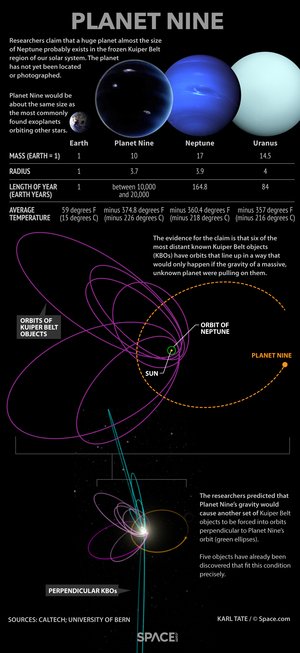Disinfo? Mysterious Planet Nine May Be a Captured 'Rogue' World
Planet Nine may be even more exotic than astronomers had thought.
The putative world, which some scientists think lurks unseen far beyond Pluto's orbit, could be a former "rogue planet" that was captured by our solar system at some point in the past, a new study suggests.
"It is very plausible" that Planet Nine is a captured rogue — a world that cruises through space unattached to a star — lead author James Vesper, an undergraduate at New Mexico State University (NMSU), said Friday (Jan. 6) during a news conference at the 229th meeting of the American Astronomical Society in Grapevine, Texas. [The Evidence for Planet Nine in Images (Gallery)]

Researchers say an anomaly in the orbits of distant Kuiper Belt objects points to the existence of an unknown planet orbiting the sun. Here's what we know of this potential "Planet Nine."
Credit: by Karl Tate, Infographics artist
Vesper and his mentor, NMSU math and physical science professor Paul Mason, performed computer simulations of 156 encounters between our solar system and rogue planets of various sizes and trajectories.
Such encounters may not be terribly uncommon; some studies indicate that rogue planets outnumber "normal" worlds circling host stars throughout the Milky Way galaxy.
The simulations suggest that, in about 60 percent of the encounters, the incoming rogue planet would be flung out of the solar system. Most of the time, this would be a relatively simple "rogue in, rogue out" affair, Vesper said. But in about 10 percent of all cases, the rogue would take at least one of our solar system's native planets with it as it departed, he added.
In about 40 percent of the encounters, however, the rogue would end up being captured by the solar system. This could happen via a "soft capture," in which no native planets are ejected, or the invader could boot one or more worlds out as it came in, Vesper said; it would depend on the rogue's characteristics.
The simulations also suggest that our solar system has likely never had an encounter with a rogue world more massive than Neptune, Vesper added. Such a big intruder probably would have stirred up the inner solar system greatly, but it remains orderly and tightly packed today, he said.
Planet Nine is thought to be perhaps 10 times more massive than Earth. (For comparison, Neptune's mass is about 17 times that of Earth.) The undiscovered world's existence was first seriously proposed in October 2014 by astronomers Scott Sheppard and Chadwick Trujillo, of the Carnegie Institution for Science in Washington, D.C., and the Gemini Observatory in Hawaii, respectively.
Sheppard and Trujillo noted that the gravitational influence of an undiscovered giant "perturber" in the outer solar system could explain oddities about the orbits of a handful of distant objects, such as the dwarf planet Sedna.
In January 2016, astronomers Konstantin Batygin and Mike Brown of the California Institute of Technology in Pasadena found further evidence for such a planet in the orbits of several additional bodies in the outer solar system. Batygin and Brown dubbed the hypothetical world Planet Nine, and calculated that it likely possesses a highly elliptical orbit that takes it as much as 1,000 astronomical units (AU) from the sun.
For perspective, 1 AU is the Earth-sun distance, about 93 million miles (150 million kilometers). Neptune lies about 30 AU from the sun, and Pluto never gets more than 49 AU from our star.
Planet Nine's putative orbit is consistent with that of a captured rogue, Vesper said. But the new simulation results don't prove anything about the origins of the hypothetical world, he stressed.
Indeed, astronomers have yet to confirm the planet's existence (though this milestone could come by early 2017, Brown has said). And other studies have deemed the rogue-planet explanation unlikely, suggesting instead that Planet Nine is a native of the solar system, or that the sun ripped the world away from another star during a long-ago close stellar encounter.
So, as can be said about pretty much all Planet Nine news and speculation, stay tuned!
John Moore "Top Special Forces Soldier Says Planet X Coming"
